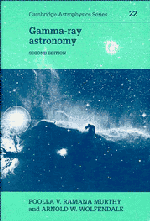5 - Ultra high energy gamma-rays
Published online by Cambridge University Press: 06 July 2010
Summary
Introduction
Studies of ultra high energy gamma-rays (UHEGR) i.e. γ-rays at energies greater than 100 GeV, provide us with information on the conditions existing in remote celestial regions, such as magnetic and electric fields, matter and radiation densities, and on the acceleration mechanisms of charged particles. Additionally such studies have an important bearing on the problem of the origin of the cosmic radiation. There is, as yet, no universally accepted identification of either the sources or the mechanisms of production of cosmic rays, though, as was pointed out in Chapter 4, there are strong arguments made in favour of some. The problem is confounded by the fact that cosmic rays, almost all of which are charged particles, undergo frequent deflections in the interstellar magnetic fields, making it impossible to know the source directions. Thus, even a primary cosmic ray proton of energy as high as 1015 eV has a Larmour radius in the ISM of only ∼ 0.3pc and has its initial direction almost isotropised. Electrically neutral radiation is free from this problem. The more commonly occurring neutral particles are neutrons, neutrinos and γ-rays. Neutrons are unstable; they would not survive in most cases from source to Earth even after allowing for relativistic time dilatation, with a decay mean free path of only 9.2 (E/1015 eV) pc. Neutrinos, being weakly interacting, are not easy to detect, γ-rays, on the other hand, are ideal as their production and interaction cross sections are rather high and they are stable.
- Type
- Chapter
- Information
- Gamma-ray Astronomy , pp. 173 - 232Publisher: Cambridge University PressPrint publication year: 1993



